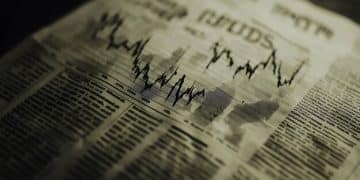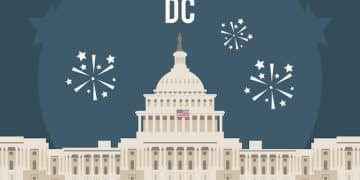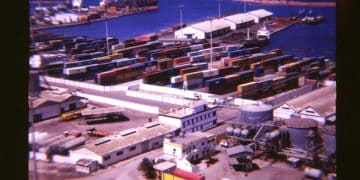Unemployment Rate Hits 50-Year Low: What It Means for the US Economy

The US unemployment rate has unexpectedly dropped to 3.5%, matching a 50-year low, signaling a potentially strong labor market but also raising concerns about inflationary pressures and the Federal Reserve’s future policy decisions.
The latest jobs report reveals a significant drop in the unemployment rate to 3.5%, a level not seen in half a century. This positive headline, however, sparks a debate about the true health of the economy and its implications for businesses and individuals alike.
Unemployment Rate at Historic Low: A Closer Look
The US labor market continues to defy expectations, with the unemployment rate reaching a historic low. This achievement raises important questions about the driving forces behind this trend and its potential ramifications.
Key Factors Contributing to the Decline
Several factors have contributed to the declining unemployment rate, suggesting a complex interplay of economic forces.
- Strong Job Creation: Businesses across various sectors are actively hiring, fueled by consumer demand and economic growth.
- Labor Force Participation: While still below pre-pandemic levels, labor force participation has shown signs of improvement, indicating more people are entering the job market.
- Skills Gap: The persistent skills gap might be contributing to a lower unemployment rate, as companies struggle to find qualified candidates, leaving fewer people unemployed for extended periods.
The confluence of these factors paints a picture of a resilient US economy, but it also introduces potential challenges that need careful consideration. A tightening labor market, while beneficial in some ways, could lead to wage inflation, impacting business profitability and consumer prices. This potentially complicates the Federal Reserve’s efforts to manage inflation and maintain economic stability.

Impact on Businesses and Industries
The historically low unemployment rate is significantly impacting businesses and industries across the US, presenting both opportunities and challenges.
Challenges for Businesses
Businesses are facing increased pressure to attract and retain talent, leading to higher labor costs and potential challenges to profitability.
- Wage Inflation: With fewer available workers, companies are compelled to offer higher wages to attract and keep employees, raising operational expenses.
- Recruitment Difficulties: Finding qualified candidates becomes more challenging, extending the time it takes to fill open positions, impacting productivity and business growth.
- Employee Retention: Businesses must invest in employee benefits and workplace culture to reduce turnover, which can be costly and disruptive.
These challenges highlight the need for businesses to adapt their strategies, focusing on employee engagement, training programs, and competitive compensation packages. Embracing technology and automation can also help mitigate the impact of a tight labor market.
The Role of the Federal Reserve
The Federal Reserve plays a crucial role in navigating the complexities of the current economic landscape, particularly in the context of the historically low unemployment rate.
Managing Inflation
The Fed’s primary goal is to maintain price stability, which involves managing inflation through various monetary policy tools.
- Interest Rate Hikes: The Fed can raise interest rates to cool down the economy, reducing demand and curbing inflationary pressures.
- Quantitative Tightening: Reducing the Fed’s balance sheet can also help tighten financial conditions, limiting the money supply and further controlling inflation.
- Forward Guidance: Communicating the Fed’s intentions and future policy decisions can influence market expectations and help manage inflationary expectations.
The Fed’s decisions are closely watched by businesses and consumers, as they have a direct impact on borrowing costs, investment decisions, and overall economic activity. Navigating the delicate balance between controlling inflation and avoiding a recession is a complex challenge that requires careful consideration of various economic indicators and global factors.

Analyzing the Broader Economic Implications
The low unemployment rate is just one piece of the economic puzzle. Understanding its broader implications requires considering various other factors and potential consequences.
Low unemployment can signal a healthy economy, but when it happens concurrently with high inflation, this becomes concerning for economic health.
An enduring low unemployment rate and high inflation can potentially lead to long term economical issues that are difficult to correct.
Impact on Different Demographics
The benefits and challenges of this low unemployment rate can vary greatly depending on the specific demographic group.
Historically disadvantaged groups can experience improvements in employment levels which helps to reduce income inequality.
- Young Adults: Recent graduates and those entering the workforce may find it easier to secure employment, but they must also navigate a highly competitive job market.
- Minority Groups: Lower unemployment rates can help reduce income inequality and provide greater economic opportunities for minority communities.
- Older Workers: Experienced professionals may find it easier to re-enter the workforce after a period of unemployment, but they must also adapt to changing skill requirements and technological advancements.
Future Outlook and Potential Risks
The future trajectory of the unemployment rate and its impact on the US economy remain uncertain, with potential risks and opportunities on the horizon.
Global economic conditions like the Ukraine war and inflation can potential contribute to changes in the long term economic landscape in America.
Potential Risks
Several risks could disrupt the current positive trend in the labor market, including global economic slowdown, geopolitical instability, and unexpected shocks.
- Recession: A potential recession could lead to significant job losses, reversing the gains made in recent years.
- Inflation Persistence: If inflation proves to be more persistent than expected, the Fed may need to maintain a restrictive monetary policy, potentially slowing down economic growth.
- Geopolitical Tensions: Escalating geopolitical tensions could disrupt supply chains and trade flows, impacting business activity and employment.
These risks highlight the need for policymakers and businesses to remain vigilant and proactive, preparing for potential challenges and adapting their strategies to mitigate negative consequences.
| Key Aspect | Brief Description |
|---|---|
| 🚀 Historic Low | Unemployment rate drops to 3.5%, matching a 50-year low. |
| 💼 Business Impact | Companies face wage inflation and recruitment challenges. |
| 🏦 Fed’s Role | The Federal Reserve manages inflation through interest rates. |
| 🌍 Economic Risks | Global instability and potential recession threaten job market. |
Frequently Asked Questions
▼
A low unemployment rate generally signifies a strong economy, indicating that more people are employed and have disposable income to spend. This can lead to increased consumer spending and economic growth.
▼
The Federal Reserve monitors the unemployment rate closely, and may implement monetary policy changes such as raising interest rates to control inflation that can arise from a tight labor market.
▼
Industries that rely heavily on consumer spending, such as retail, hospitality, and entertainment, often benefit from low unemployment as more people have disposable income to spend on goods and services.
▼
One potential downside is wage inflation. With fewer available workers, companies may have to increase wages to attract and retain employees, which increase overall costs for doing business.
▼
Businesses can prepare by investing in employee training and development. Creating strong company culture can also improve hiring ability for companies during times when the job pool is shallow.
Conclusion
The drop in the unemployment rate to a 50-year low presents a complex picture of the US economy. While it signals a strong labor market, it also raises concerns about inflation and the challenges faced by businesses. Navigating this landscape requires careful monitoring, strategic decision-making, and a proactive approach to managing potential risks and opportunities. Businesses should prepare to adopt to modern times and to the economical landscape to ensure they are around for the long haul.





